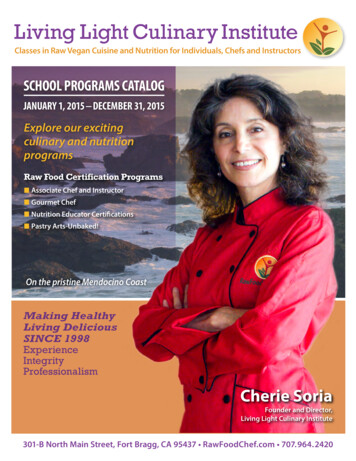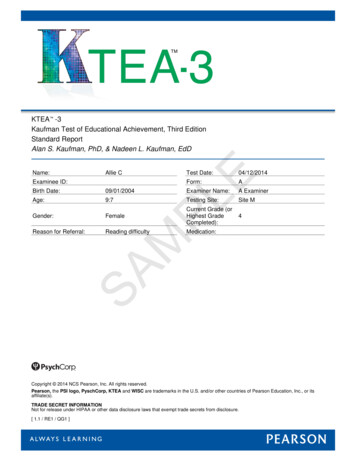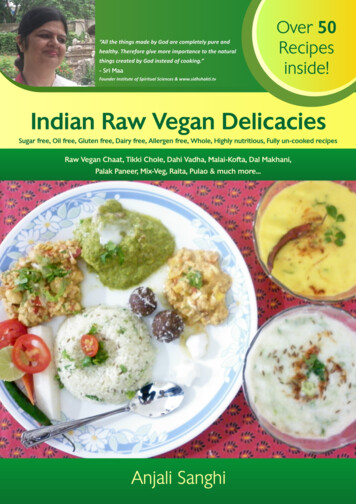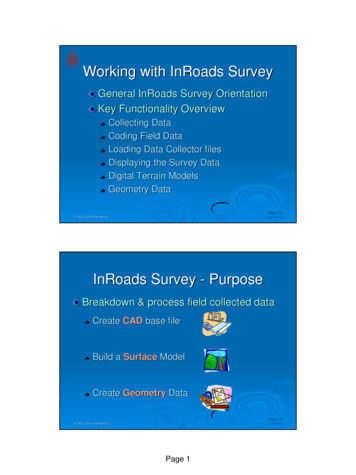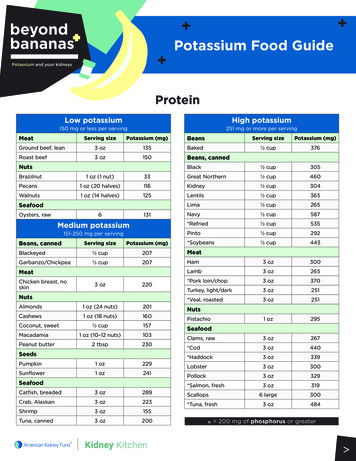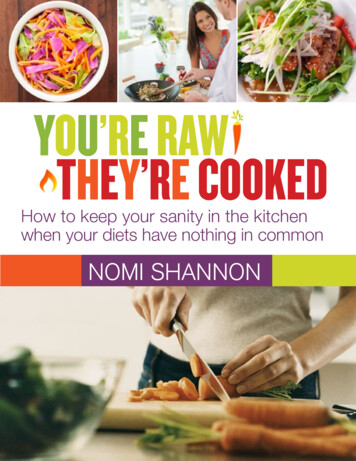
Transcription
YOU’RE RAWTHEY’RE COOKEDHow to keep your sanity in the kitchenwhen your diets have nothing in commonNOMI SHANNON
This book is dedicated to the over quarter of a million people who have boughtmy books, and the many who have taken my online raw food support courses andbooked personal consultations with me. I appreciate you more than I canarticulate. In particular, the online support groups reveal the real life happeningsof aspiring and accomplished raw fooders. Trends appear. This eBook has beencreated in response to one such trend.YOU’RE RAW THEY’RE COOKEDHow to keep your sanity in the kitchenwhen your diets have nothing in common 2013 Nomi Shannon, Rocky Dog PublishingGraphic Design: Deborah GaffaneyRocky Dog PublishingThe Raw GourmetP. O. BOX 160Bonsall CA 92003888-316-4611ALL RIGHTS RESERVED. No portion of this eBook may be reproduced or by any means whatsoever,except for brief quotations in reviews, without written permission from the publisher/author.LEGAL NOTICES:The information presented herein represents the view of the author as of the date of publication.This book is forinformational purposes only. While every attempt has been made to verify the information provided in this book, theauthors does not assume any responsibility for errors, inaccuracies or omissions. If advice concerning dietary orrelated health matters is needed, the services of a fully qualified professional should be sought. This book is not intendedfor use as a source of medical or nutritional advice.
TABLE OF CONTENTSINTRODUCTION:Being Raw in a Non-Raw Familypage 1page 3Chapter 2:The Flavors of Italypage 6Chapter 3:Asian Inspired Cuisinepage 14Chapter 4:Traditional American Tastespage 26Chapter 5:The ABCs of Making Great Souppage 37Chapter 6:Classic French Inspirationspage 49Chapter 7:Concept Saladspage 55Chapter 8:Bread and Crackerspage 61Chapter 10:Chapter 11:Quick ‘n’ Easy RecipesEating Well on a Budgetpage 65page69Raw Food termsAbout Nomi Shannonpage 79page 82Chapter 1:THE RECIPES:ADDENDUM:Glossary:Bio:
INTRODUCTIONIn the online raw food support groupsthat I’ve been running for over tenyears, one topic that comes up everytime is the very common issue of onefamily eating two different ways. Often,it’s the wife who is all- or high-raw, andthe husband is either a big meat eateror might eat some of her “rabbit food;”but she always winds up preparingseparate meals to accommodate themboth.Another common scenario is a familywith multiple children where the momis the only person in the family who isall or high-raw. Historically, this has resulted in “the lady of the house” having to prepare twototally separate meals in order to feed the whole family. Being the sole person who eats raw in thefamily can be stressful on many levels. The dynamics and practicalities of families with both rawand cooked members is complex, to say the least; and it frequently leads to the “Raw Person”simply giving up.For starters, there is the tendency to judge or worry. Once you make the decision to change theway you eat for the betterment of your health, it very often follows that you will want to bring alongthe rest of your world. So, you start to worry about your loved ones’ health. In some cases, therecan be a tendency to judge others who are not changing right along with you; or at least youWISH that the rest of the tribe were going along for the ride.Sooner or later, most early converts to a raw food lifestyle come to understand that we are eachon our own path and that trying to force your new nutrition paradigm on your family can oftenlead to bad feelings and tension. I’ve probably said this a million times, but it’s still true: The onlyway to really win over uninterested friends or family members is to be such a shining example ofgood health and good cheer that eventually they will notice and want some of that.Keep in mind when you see your five-year-old eating pizza (and just who introduced him to pizza1
in the first place?); and you are now thinking, “OMG, he’s killing himself”, remember that youmanaged to eat that way for many years. And now that you are a raw-convert and feeling somuch cleaner and clearer and better, there is time for him to come around – lots of time. Forcinggreen things on him before he’s ready well, it’s just not going to work. (But remind me to tell youabout Shrek Smoothies.)So, let’s see where you are with this: You are eating raw. Others in your life aren’t. You’re the chiefcook and bottle-washer in the house. So Thus, begins a long, tiring saga of Momma making at least two different dinners each night.Eventually, as we all know too well, this arrangement breaks down, because it is just too muchwork; it’s confusing, and it’s costly.Now, there is finally a way to make everyone happy by using recipes that are a fusion of raw andcooked – the same foods but with different treatments.In this eBook, I will be teaching you how – for each meal – you will be able to use the same setof ingredients to create both a raw and a cooked version. You may be adding to the plate of yourBeloved Cooked Food Person something that you personally won’t be eating, but it will be asimple add-on. Once you’ve mastered this method, sanity will return to your kitchen.Soon you will be learning how to take a cooked recipe and create a raw version of it, as well astaking a raw recipe and creating its cooked counterpart. Once you get the hang of this, you willbe doing this very efficiently on your own.This will take you much less time and trouble than it takes to create two entirely different mealsevery time your family eats together. So, let’s get started but first, a little bit about attitude 2
CHAPTER ONE: BEING RAW IN A NON-RAW FAMILYBRINGING RAW SLOWLY AND GENTLYINTO YOUR FAMILYHere is a great post from one of the members of my eight-week programhttp://www.RawFoodfortheRealWorld.com, regarding her approach to being raw withher family that isn’t raw. I feel that this lady has the wisdom of the ages in her lovingapproach. Perhaps it will help you in your journey, as well.I have three children (a seven-year-old and five-year-old twins), and I’ve been dabbling in the rawlifestyle for about two years. My husband enjoys everything (well, ALMOST everything.) raw thatI have prepared - only as a side dish but that’s a start. Just in the last few months have I gottenmore serious about raw foods. I make a green smoothie every day, and the kids all have one (about4-6 ounces) every afternoon when school is over. (We home-school.) The children also get E3Live acouple of times per week. It’s funny: If you get into a routine with children, it doesn’t take them longto accept it as the norm.Now, as for the meals: I tend to make two meals, too, because I’m cooking for my husband andthe kids. However, we eat a salad every evening; and we do it “just like the restaurants do.” (Thekids think this is fun.) We have the salad before any other food is put on the table. So, they’regetting their raw that way; and I found that if we take our time eating the salad, they eat more of itand are less hungry for the cooked food.My kids are not picky eaters, and our salads can consist of any combination of spinach, carrots,avocados, lettuce, beets, radishes, onions, celery, tomatoes, cucumbers and green peas, mostof which is from our own garden. It helps that they were involved in planting it, caring for it andharvesting it. The kids are definitely more interested. Also, when I cook, I tend to make a big potof spaghetti sauce (sometimes meatless, sometimes not), or vegetable/chicken soup or chili, sothat they can have leftovers, which frees me up a little bit for that next evening.Also, do you remember your mother telling you, “no, you cannot have an apple,” (or banana orpear. or. fill in the blank) “because it’s too close to dinnertime; and I don’t want you to spoilyour appetite?” Well, I decided that it was a GREAT idea that the kids want fruit, because whenwe wait for Daddy to come home for dinner (6:20-6:30PM), the kids are pretty hungry.So, I always prepare a plate of two fruits (apple, pear, kiwi, pineapple, oranges, banana, papaya,persimmons, etc.) cut up and ready for them.I prefer that the children fill their tummies with this organic food before sitting down to thetable. They consider it quite a treat. I would suggest that you continue on your path, and they3
will show interest. (How couldboys NOT be interested in theVitamix when it’s making all thatnoise? That sound always bringsmy three kids running to see whatI’m doing.)On a daily basis, maybe you canincorporate a salad of some kindinto their meals. I let mine usewhatever dressing they want, too.I’d rather they eat the raw foodwith store-bought (gag) dressingthan to not eat the raw vegetablesat all. Sometimes, I pre-dress thesalad or slaw with a dressing that I’ve made; and the children don’t complain too much, aslong as it’s an oil- (flax, but they don’t know that) and (apple cider) vinegar-based dressing.No, they don’t always want what I’m making, but they are always required at least to tasteit. And, no, I’m not 100% raw, either, though 100% is my goal. Right now, if I do havecooked food, it’s only at dinner; and I don’t have it at every dinner. Sometimes, I’m not evenhungry (because I might have enjoyed a green drink while making their dinner), so I’m nottempted to eat the cooked foods.Our oldest son asks a lot of questions (like any seven-year-old, I guess.); so, he’s beginning tounderstand the reason why I’m changing my eating habits, and he calls me his “raw food girl.”It CAN get stressful, preparing all this food; but I find that the snacks that this group has puttogether are life-savers. [ From Nomi: The writer is referring to a healthy, raw snack list that getsbuilt during my eight-week Raw Food Support course. This is something that will save you timeafter-time, because if you always have something fast and yummy on hand, you can happilyresist the temptation of foods that you might regret eating later.] You can’t be hungry when you’remaking the cooked food for your family, or you will succumb to the temptations.Keep those snacks handy; keep the green smoothies prepared and ready on a daily basis;keep fresh, organic fruit and vegetables cleaned and ready to eat. (My counters are FULL offresh fruit and veggies at all times for whenever we get hungry.) And, keep a smile on your face,too. (Whenever I see the pained look on joggers’ faces, I wonder the reason why they do it.)So, I try to keep it fun for myself AND for my family, so that they can see that it’s an enjoyableway of life and not a struggle. I have my moments, don’t get me wrong; but it’s usuallybecause I failed to plan, and that’s just my own fault. If something unforeseen comes up inthe family schedule and I have to eat cooked food, I don’t sweat it. I just get back on my rawlifestyle as soon as possible, and I don’t beat myself up about it. I hope this helps.4
THE RECIPES5
CHAPTER 2: THE FLAVORS OF ITALYItalian Food is one of the most popular cuisines in the U.S. The most popular herbs andspices used to make Italian food are Basil and Oregano, they taste wonderful fresh butboth are available dried. Other important tastes of Italian cuisine are: garlic, olive oil,parsely, rosemary and thyme. I mention Frontier Spice Pizza Seasoning quite often, it isa mix of all the wonderful Italian flavors. I use it for all my Italian inspired foods as well asAsian and also just because, it is my favorite seasoning mix.PASTANothing makes people happier than a pasta meal. The warming part is especially easywith this recipe. While you’ll be enjoying raw, spiralized zucchini, you’ll serve your nonraw folks the pesto sauce mixed in hot, non-wheat pasta (non-wheat, if possible, that is)and topped with warmed marinara.Truth be told, I just put the raw, unheated marinaraon top of the hot pasta. A quick tosss of the hotpasta with the unheated Marinara quickly warmsthe sauce.But you can warm it up quickly and simply,either in a saucepan directly on low heat(stirring constantly) or over a double boiler,stirring often.Special Note: I often read that people warmthings up in the dehydrator. I think that this is abad idea because a long, slow warming invitesmold and spoilage. Dehydration is designed totake less-wet foods, like a cracker batter, anddry it completely. It is not designed to warm aliquid, like soup. Just heat it up quicklyon the stove top.6
PASTA WITH PESTO AND MARINAMake your pasta using a Saladacco*, or simply make wide noodles with a potato peeler. If youdon’t have the time to soak the pine nuts, the recipe will turn out fine with unsoaked pine nuts.PESTO SAUCEIngredients:¼ cup pine nuts, soaked 20 minutes¾ cup extra-virgin olive oil6 cloves garlic, chopped¾ cup roughly-chopped, fresh basil (or more totaste)2 Tablespoons chopped, fresh parsley¼ teaspoon sea saltDirections:In a blender, combine the pine nuts, oil, garlic,basil, parsley and salt. Blend until very smooth.If the sauce is too thick, add a spoonful ofwarm water.Yields 1½ cups.7
MARINARA SAUCESave any leftover marinara to make pizza the following night.The marinara should keep in a well-running refrigerator for 3 -4 days.Ingredients:2-3 cups Sun-dried tomatoes, soakedin water for 2 hours (not oil-packed;buy plain, dry, dehydrated sun-driedtomatoes if you can.)8-10 fresh tomatoesParsleyOnionGarlicFresh BasilOreganoSea SaltOlive Oil1-2 dates (optional)Directions:If making this marinara sauce to use on zucchini pasta that has been tossed in pesto sauce,this will make more than enough for 8 people as an entrée and 16 people as a side dish.Cut up and blend the tomatoes in a blender. You should have approximately 3 cups of pureedtomato. If necessary, add more tomatoes until you reach that amount. Drain the sun-driedtomatoes. (Save the liquid to thin the sauce later, if you need to.) Add enough of them to thetomato puree until the mixture is quite thick and dark red.Add the following to your liking: garlic, onion, a little olive oil, parsley, fresh basil, sea salt andoregano. (Add any other ingredients that you like in a tomato or marinara sauce. Cut- upolives would be nice.)Taste and adjust seasonings. I usually wind up using 1-2 dates to get the flavor I want.8
POMODORO SAUCEMake this recipe in the summertime when tomatoes are so delicious, insteadof the marinara sauce, which is a classic to make in the winter.I like to prep this in the early AM and leave it out, soaking in a colanderover a bowl until time to eat dinner.Classically Italian, this recipe takes advantage of the plentiful crop of fresh, luscious summertomatoes, ripened on the vine. Be sure to use the very best tomatoes you can find (heirloomor vine- ripened).Ingredients:4-6 tomatoes, diced¼ to ½ cup basil, chiffonade*2 teaspoons sea saltAdditional fresh basil, to tasteDirections:In a colander, put the tomatoes, saltand the slivered basil. Drain a minimumof 2-3 hours. (Tastes best if left to drainall day.)Serve as-is over zucchini pasta, or makepesto sauce. Then, toss the pasta – firstwith pesto, then, put pomodoro sauce on top of the pesto/pasta mixture. (Mixing sauces togetherresults in an unattractive, brown mix. Be sure to put the pomodoro sauce on top of your pasta/pesto mixture).To serve this warm, simply add the raw pesto to the hot pasta, then top with thepomodoro without heating either.You can increase the warm sensation by first rinsing the pasta bowl in very hot water,quickly towel dry, then add the very hot pasta, mix in your sauce; and the temperatureshould come up high enough to please any cooked fooder.9
PASTA ALFREDOThis world-famous white sauce for pasta is often combined with vegetablesfor a pasta primavera. Variations are below:Ingredients:1 cup raw macadamia nuts1 cup raw cashews½ cup raw pine nuts1 cup water (more or less, as needed)Juice from 2 lemons2-4 Tablespoons nutritional yeast1½ teaspoons Tamari or¾ teaspoon sea saltDirections:Soak the nuts/seeds in water for twohours. Drain, rinse well, and drainagain.Place ingredients in blender, and blend until smooth, adding more water (only if necessary)to achieve a thick consistency.Additions:Many of the Alfredo recipes call for garlic. Some call for oregano and others parsley.If you love garlic, add in ½-1 clove with the rest of the ingredients. At the end, you can pulsechop in oregano or parsley, if you’d like.Refrigerate 2-3 hours. Your Alfredo sauce should be like a thick sour cream.Use over zucchini pasta. If you are looking for a strong-flavored meal, you might want to tossyour pasta first with pesto sauce; then, top with the Alfredo. Along with a green salad, thiswould make a very impressive dinner for guests.For the cooked version: serve in a hot bowl with hot, cooked pasta topped with theAlfredo sauce. With the sauce mixed in right away, you shouldn’t even have to warm it.Your non-raw eaters might appreciate this served with grated parmesan cheese or similar.I’d be happy with a bit more nutritional yeast, or try the Rawmesan Cheeze recipeon page 12.0
VARIATIONS OF ALFREDO SAUCE:GREEN HERB SAUCE(Good with zucchini, parsnip or carrot pasta)Ingredients:Use one cup of Alfredo Sauce and stir in:1 handful of spinach, finely chopped4 fresh oregano leaves, chopped6 fresh basil leaves, choppedCREAMY TOMATO SAUCEThis recipe calls for tomatoes that have been diced, then sprinkledwith salt and allowed to drain for a day.Ingredients:8 Roma or plum tomatoes finely chopped1 Tablespoon sea saltDirections:Mix tomatoes and salt, and put ina colander. Allow to drain for 6-12hours.Blot tomatoes until very dry (or putin dehydrator for 20 minutes).Mix into one cup of Alfredo sauce.q
RAWMESAN CHEEZEIngredients:2 cups nutritional yeast*1½ cups walnuts1¼ Tablespoons chopped,dehydrated garlic¾ teaspoon Celtic, Himlayan or sea saltPinch of cayennePinch of Italian seasoningDirections:Pulse-blend all ingredients in a heavyduty blender until uniformly fine. Store in acovered jar in the refrigerator. Use this asyou would Parmesan cheese sprinkledover your sauce and on top of pasta.ITALIAN-STYLE COOKED CAULIFLOWERA friend lived in Italy for a few years and came home with this recipe:Ingredients:1 or 2 heads of cauliflowerolive oilsaltherbs: rosemary, garlic, Herbs de Provence, etc.Directions:Make large, ¼” slices cutting from the top to the bottom of the cauliflower. Lay the slices on agreased pan. Drizzle with olive oil and salt. Bake at 450º Farenheit for 45 minutes or untilbrowned in spots. About half-way through, flip slices over. Great served hot or cold.w
PIZZAFor this recipe, you are going to need a slice of onion bread. (See recipe, on page 11.)Or you can purchase something similar, here:http://www.therawfoodworld.com/index.phpThis is an excellent source also for olives, nuts, nut butters, and snacks. Look for the onionbread or similar under “bread.” The food at this site is all RAW, unless it says otherwise.For your Cooked Family Members, if you don’t think they’d like the raw crustversion, how about a store-bought pizza crust? Then, add some of these sauces, a bitof cheese and something else they like salami? I don’t know, but you do. Heat it up;sit down together, and enjoy. Right? Right.Directions:So, your pizza crust is the onion bread.Then, you can use the Alfredo frompage 10. This is also called White Sauce. It’scheesy-tasting and yummy. Spread it on thebread; or if you prefer, use some sunflower pâtéSee Page 27), instead, or whatever you have onhand.Then, on top of that, use a marinara sauce. (Seepage 8.) But, hey you don’t have to get allfancy: Just chop up a tomato; put a little sea salt,Trocomare * or Herbamare* on it. You can addsome Frontier Pizza Seasoning and pile that ontop of the white sauce.Then, use any or all of these: Chopped basil Chopped olives Chopped fresh oregano Chopped onions, shallots or scallions Chopped red pepper Or whatever suits you mushroomse
CHAPTER 3: ASIAN INSPIRED CUISINEThe flavors of Asia show up as: Ginger, garlic, toasted sesame oil, soy sauce (and similar),basil, scallions, Star Anise, Chinese Five spice seasoning, cilantro/coriander, galangal,lemongreass, kefir lime leaves, chiles,etc.GADO GADO WITH YAM PASTA(Recipe adapted from The Raw Gourmet ( Nomi Shannon, 1999, Books Alive)Pasta: With this yummy, Indonesian-style sauce, use sweet potato, yam or hard winter squashfor your pasta. Apparently, some people soak the sweet potato in water for a few hours torelease the starch. I’ve never done this and never felt like I’ve needed to.Use one small-to-medium-sized yam per person for an entrée.This highly-flavored sauce can be made into a sweeter type of sauce with the simple additionof additional dates, raisins, some agave or a bit of stevia.Ingredients:½ cup water1 cup almond butterJuice from 1 lemon1 Tablespoon wheat-free Tamari or similar1 Tablespoon honey or agave2-4 Tablespoons coarsely-chopped onion2 cloves garlic, chopped1 Tablespoon grated, fresh ginger root1 Tablespoon sesame oil½-1 teaspoon cayenne pepper2 dates (optional)Directions:In a blender, blend all ingredients (except the dates) until smooth and creamy, adding additionalwater, if needed, to achieve the consistency of a smooth, thick soup. Taste. Add two dates; blend,and add any additional dates or other suggested sweeteners, if desired. Yield: 2½ cups.For the cooked version, cook rice noodles following package directions; then, tossin the sauce. It should warm up sufficiently, if the pasta is hot right from the pot. YUM.r
PAD THAI NOODLES(Recipe adapted from Raw Food Celebrations, ( Shannon/Duruz, 2008, Books Alive)While traditional Pad Thai noodles are thicker than the standard angel hair pasta shape that ismade using the Saladacco, the Pad Thai sauce works well with this shape. There are also somemachines that make a linguine-style pasta, which is more like traditional Pad Thai noodles. Thisrecipe calls for both zucchini and carrot pasta with some fresh, mung bean sprouts, too.Yields 8-to-10 servings.Make your sauce first, so it will be ready to pour immediately over the zucchini pasta to avoidtoo much moisture weeping from the zucchini.Ingredients:Pad Thai Noodle Mixture4 medium zucchini2 medium-to-large carrots½ cup chopped cilantro, leaves only½ cup mung bean sproutsPAD THAI SAUCEIngredients2 cups almond butterJuice from 2 orangesJuice from 1 lemon2 Tablespoons grated fresh gingerJuice from 1 lime4 cloves garlic, minced8 pitted Medjool datesDirections:Sauce:Combine all sauce ingredients in a blender, and blend until smooth. Add additional water, ifnecessary; but the sauce should be thick.Noodles:Chop cilantro. Spiralize zucchini and carrot. (I don’t peel the zucchini, but some people prefer toso that the noodles are all white.) Mix noodles, mung bean sprouts and cilantro together in a bowl.Pour sauce over the noodle mixture, and mix gently but well.For the heated version, use either hot rice noodles or pour heated sauce over the rawpasta, and mix well. To heat the sauce, gently warm it in a sauce pan. If your CookedPerson isn’t going to enjoy the crunchiness of the raw zucchini and carrots, a quicksteaming* should take care of that.t
GARNISH FOR PAD THAI NOODLE RECIPEGarnish:4 green onions (scallions), chopped4 Tablespoons chopped basil10-12 wedges of fresh lime8 raw almonds, choppedGarnish: If using, either decorate a serving platter with the garnish or distribute amongindividual plates. Each person can squeeze as much or as little lime juice as he or she wouldlike on the dishCARROT PASTA WITHINDONESIAN YUM-YUM SAUCEMake carrot pasta with the Saladacco, the Spirooli or Spiralo on the thinnest setting. Keepmaking it until you have a bowlful. (You can also make pasta simply by using your vegetablepeeler and making long, carrot strands with it.)This is also excellent with Gado Gado Sauce. (See page 14.)INDONESIAN YUM-YUM SAUCEIngredients:½ cup water (or fresh coconut water, if you have it)3-4 Tablespoons raw almond butter2 teaspoons raisins (soaked 20 minutes), optional¾ teaspoon Nama Shoyu or wheat-free Tamari½ teaspoon Chinese five-spice powder1 clove garlic1 teaspoon ground flax seedBlend well. Refrigerate. Will keep for a few days. Pour over carrot pasta.Can be warmed in a pot on the stove, stirring constantly until warm to the touch. (Ifyou’d like the carrots to also be hot as well as a bit softened, pour hot (not boiling)water over the carrots. Drain, then put carrots in a hot dish and pour the warm sauceover for a warm meal.Both the cooked and raw versions of this meal can be served with a simple green salad witha bit of lemon squeezed over it. Suggested greens: kale, mustard, cabbage or bok choy.y
ASIAN PÂTÉNotes:Take 3-4 cups Sunflower pâté (see recipe on page 28) and add:Ingredients: 1/4 cup finely chopped mild onions 1/4 cup finely chopped minced parsley 1 red pepper, finely chopped ½ cup chopped cilantro ¼ cup slivered Chinese snow peasDirections:Add enough Asian Dressing to the mix to moisten and bind the ingredients. Mix well.Mixture will thicken in the refrigerator.(Original Gado-Gado is made with peanut butter,but there is a naturally occurring fungus called“aflatoxin” in the peanut crop. This is a provencarcinogen, so I substitute almond butter. Anotherreason for preferring almond butter over peanutbutter is that peanut butter is never raw. Peanutsare legumes and need to be cooked. Almondbutter is available both raw and cooked, andsome people make their own at home.)FLASH TIDBIT:HOW TO USE PULPQuestion: I’m wondering what to do with thepulp after juicing. I’m holding off juicing much,as I was producing a lot of pulp; and the onlyrecipes I can find are for cooked pulp. Applepulp is a particular problem, as it goes funnyalmost straight away.You could also mix your pulp and perhapssome diced-up veggies with a nut- or seedcheese. Then, you can wrap it in a lettuce orcabbage leaf or a piece of nori. If you aremaking soup, you can add a bit of the veggiepulp to the soup. Or make a creamy dressing:Add some pulp and seasonings, and use as adip with courgette (zucchini) slices or carrotand celery sticks.Answer: Juicing is all about giving the body arest from digesting, assimilating and eliminatingwhile giving it a big hit of easily assimilatednourishment in the form of juice. Practical typeshate to throw away all that pulp, but it is actuallycounter-productive to then eat it.That being said, here are a few ideas for thatleftover pulp. You can use veggie pulp simplymixed up with a nice dressing. To keep thetexture interesting, combine it with diced celery,red pepper, onion, tomato or any other veggiesyou have on hand. This works especially wellwith a creamy dressing. Try guacamole or atahini-based dressing. Check out the recipe forGado-Gado dressing on page 14. It is a thick,sweet, exotic-tasting dressing.One of my favorite uses for pulp is to feed it tothe Grand Dog and Grand Cat; they act like it isa big treat. Pulp more closely resembles thefood that they would eat in the wild than thecereal-based pet foods. Raw meat, bones andlots of pulp would make the ideal dog food.If you make crackers in your dehydrator,experiment with adding some pulp to them.u
ASIAN DRESSINGNotes:This dressing will make anything taste Asian – great to flavor sunflower pâté or use as a saladdressing. This dressing will keep in the refrigerator for several weeks.Here are two versions: One is family-size; You make it and shake it in a jar to yieldapproximately one cup. One is a party-size dressing. You make in a blender, and it yieldsapproximately 3½ cups.Family-size Asian dressing:Ingredients: 2 Tablespoons raw tahini 5 Tablespoons water or more, to taste 4 Tablespoons wheat-free Tamari or other liquid, salty substitute 1/2 cup minced scallions 1-2 Tablespoons flax seed oil 1-2 Tablespoons sesame oil, toasted for best flavor, if you are not 100% raw 1-2 Tablespoons honey -- tastes best, but use agave, if you prefer.Honey is not vegan. 1-2 Tablespoons grated fresh ginger 1 clove garlic, pressed 1/2 teaspoon Chinese Five Spice powder 1/4 teaspoon cayenne pepper 1/4 teaspoon ground cuminDirections:FOR THE FAMILY SIZE, PLACE ALL INGREDIENTS INTO A PINT JAR; PUT ON THE COVER, AND SHAKE.FOR THE PARTY SIZE:In a blender, blend all ingredients until fairly smooth. Add a cup or so of this dressing to thepâté, then more, as necessary, for taste and texture. You can adjust texture with additionalpâté, as well. This will be a soft pâté, like hummus or onion dip. Use it to fill veggies, like half apepper; or top off a salad with it. Dip some sliced daikon radish or zucchini spears in it, andknow you are giving yourself some terrific nutrition.Other yummy items that you can add to this pâté to bring out the Asian flavor in it are:chopped cilantro, minced celery, chopped snow peas, finely minced carrot or red pepper,chopped leeks and/or chopped shallots.i
ASIAN STIR FRYWay back so long ago – I almost forgot about it until I found some cookbooks I used – I was avery accomplished, Asian-style home chef.Back in the day when I was a housewife,I took the culinary aspect of it veryseriously. The amount of time it took togrind, chop, marinate and slice manydifferent ways was all a joy to me. My wokwas always out, and I used it often.While thinking of recipes that could beraw fusion, same foods/ differenttreatments, I realized that the stir-fry is thePERFECT, cooked/not cooked solution.Pick up just about ANY Asian/Chinese/Oriental cookbook, and you will get manyideas for combinations of veggies to use; and if your Cooked Honey eats flesh foods, it is justso easy to plop on that bit of fish or chicken (or whatever he likes), as well as tofu-type foods.Those same combinations will work as a raw dish. Now, you can be real simple and finelychop or grate, slice and sliver up a mix for yourself, then top your dish with a nice dressing orsauce. (Asian Dressing on Page 18, Orange Tahini Dressing on 57 or Gado Gado
TABLE OF CONTENTS INTRODUCTION: page 1 Chapter 1: Being Raw in a Non-Raw Family page 3 THE RECIPES: Chapter 2: The Flavors of Italy page 6 Chapter 3: Asian Inspired Cuisine page 14 Chapter 4: Traditional American Tastes page 26 Chapter 5: The ABCs of Making Great Soup page 37 Chapter 6: Classic French Inspirations page 49 Chapter 7: Concept Salads page 55


